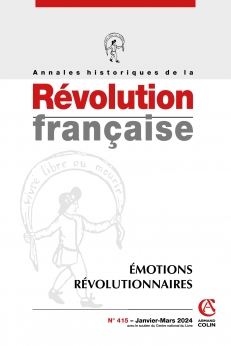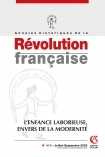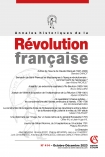
ANNALES HISTORIQUES DE LA RÉVOLUTION FRANÇAISE Nº415 (1/2024)
Pour acheter ce numéro, contactez-nous
Recevez les numéros de l'année en cours et accédez à l'intégralité des articles en ligne.
La Révolution française n’a aucun sens sans une compréhension du rôle que jouent les émotions : l’euphorie du succès, la fureur contre ceux jugés responsables de la souffrance, la fierté dans le triomphe et, par-dessus tout, la peur de la violence, des complots, de la trahison et de la mort. Selon William Reddy, cependant, le sentimentalisme était l’émotion clé, et Maximilien Robespierre personnifiait les excès de son expression. La « terreur » était « un champ de bataille émotionnel ». La thèse de cet article est que, pour comprendre l’histoire émotionnelle de Robespierre, nous devons plutôt adopter une approche holistique qui intègre l’expression de ses émotions, dans toute sa complexité, aux circonstances individuelles de son existence et aux exigences de la crise révolutionnaire.
The French Revolution makes no sense without an understanding of the role played by emotions: the euphoria of success, the fury against those judged responsible for the suffering, the pride in triumph and, above all, the fear of violence, plots, treason, and death. ForWilliamReddy, however, sentimentality was the key emotion, and Maximilien Robespierre personified the excesses of its expression. The “terror” was “an emotional battlefield”. The argument of this article on the other hand is that to understand Robespierre’s emotional history, it is necessary to adopt a holistic approach that integrates the expression of his emotions in all their complexity with the specific circumstances of his existence and the exigencies of the revolutionary crisis.

